ECON6000 Assessment 2: Australian Economic Profile and COVID Impact
VerifiedAdded on 2023/01/11
|16
|2825
|71
Report
AI Summary
This case study report provides a comprehensive analysis of the Australian economy, focusing on its macroeconomic performance from 2014 to the most recent available data. The report assesses key indicators such as GDP per capita, inflation, and unemployment, offering insights into the country's economic health. A significant portion of the report is dedicated to evaluating the negative impact of COVID-19 on the Australian economy, examining the effects on various sectors and the policy measures adopted to mitigate the crisis. The analysis includes an examination of unemployment rates and the fluctuations observed over the years, especially the impact of the economic crises. The study also contrasts Australia's response to the pandemic with China's, highlighting specific macroeconomic policy measures. Overall, the report serves as an economic profile of Australia with recommendations for the government, providing a detailed understanding of the economic landscape and challenges faced by the country.
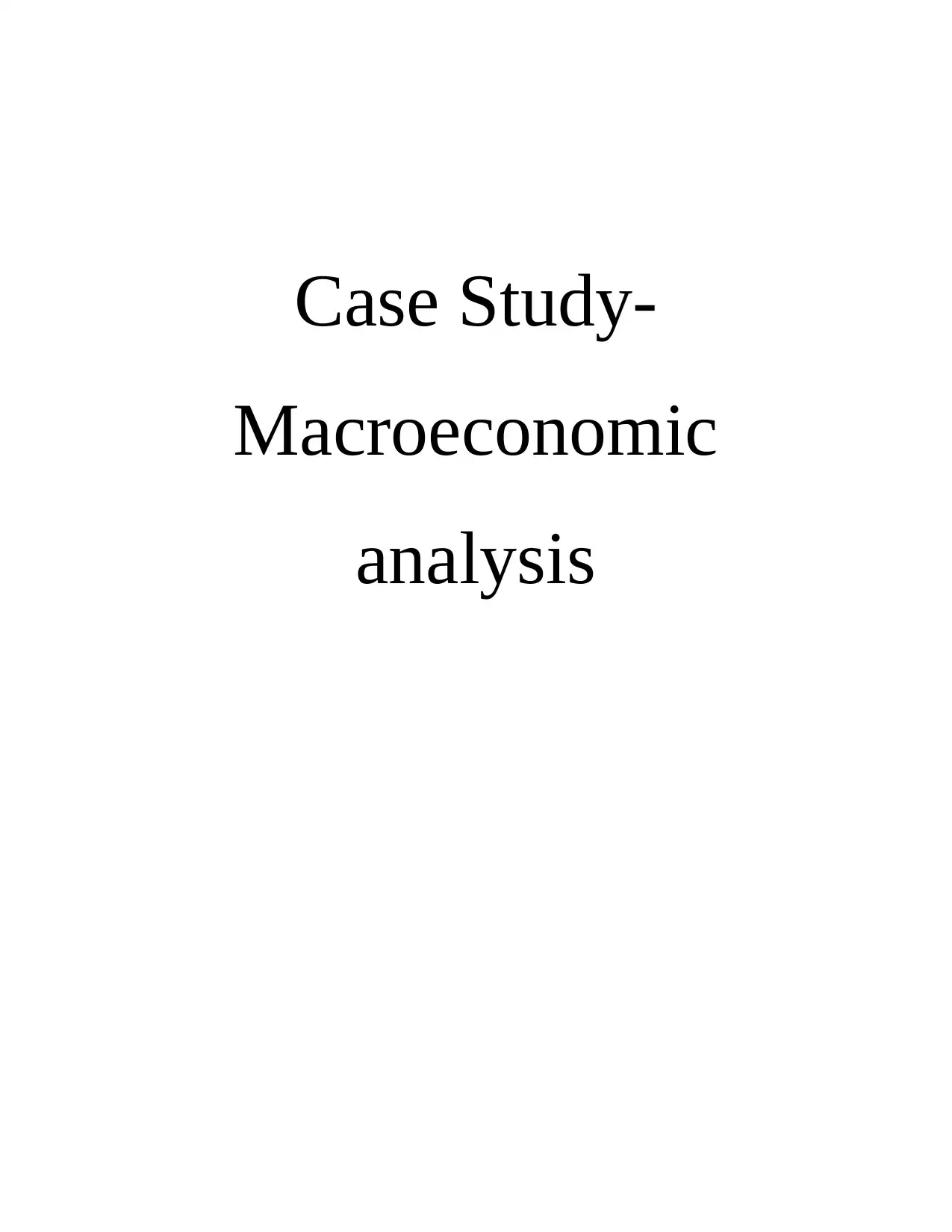
Case Study-
Macroeconomic
analysis
Macroeconomic
analysis
Paraphrase This Document
Need a fresh take? Get an instant paraphrase of this document with our AI Paraphraser

Table of Contents
EXECUTIVE SUMMARY.............................................................................................................3
Macroeconomics performance and Social impact...........................................................................4
A) Assessment of macroeconomic performance of the Australian economy..............................4
B) Negative impact of COVID-19 on economy........................................................................10
CONCLUSION AND RECOMMENDATION............................................................................13
REFERENCES..............................................................................................................................14
EXECUTIVE SUMMARY.............................................................................................................3
Macroeconomics performance and Social impact...........................................................................4
A) Assessment of macroeconomic performance of the Australian economy..............................4
B) Negative impact of COVID-19 on economy........................................................................10
CONCLUSION AND RECOMMENDATION............................................................................13
REFERENCES..............................................................................................................................14

EXECUTIVE SUMMARY
An economy is a wide variety of interrelated output and usage processes that help to
decide the distribution of finite capital. Manufacture and sale of products and services is used to
satisfy the needs of citizens who work and operate in the community, often called an economic
structure. The project report summarizes about macro economics performance of Australian
economy and social impact. Under the report impact of COVID 19 on Australian economy is
mentioned in detailed manner. As well as GDP per capita, inflation rate and many more are
described in detailed manner.
An economy is a wide variety of interrelated output and usage processes that help to
decide the distribution of finite capital. Manufacture and sale of products and services is used to
satisfy the needs of citizens who work and operate in the community, often called an economic
structure. The project report summarizes about macro economics performance of Australian
economy and social impact. Under the report impact of COVID 19 on Australian economy is
mentioned in detailed manner. As well as GDP per capita, inflation rate and many more are
described in detailed manner.
⊘ This is a preview!⊘
Do you want full access?
Subscribe today to unlock all pages.

Trusted by 1+ million students worldwide

Macroeconomics performance and Social impact
The pace of annual economic growth of the Australian economy fell to the lowest level in the
past decade. According to data released on Wednesday, Australia's GDP growth in the year
ended June was just 1.4 per cent. Australia considers the period from July 1 to June 30 of the
next year to be a financial year. According to data from the Australian Bureau of Statistics, the
country's economy grew at a mere 0.40 percent in the April-June quarter. Australia has managed
to avert recession for almost 28 years. But the data released on Wednesday has created a
situation of concern about the country's economic scenario. The country's central bank lowered
the main interest rate to a record one percent on Tuesday due to weak buying sentiment by
customers. Analysts believe that banks may cut interest rates in the coming months to strengthen
the economy.
A) Assessment of macroeconomic performance of the Australian economy
The need for an important financial system in Australia is to maintain sustainable
macroeconomic mechanisms and require more roots in the search for energy (Bick and Fuchs-
Schündeln, 2018). Various requirements recall the maintenance of macro potential agreements to
reduce budgetary threats on a large scale and increase the support of the current framework with
current service changes, continuity and growth conflict and changes in the viability strategy.
Australia's progress along with the quest for housing and commerce will encourage long-term
growth.
Listed below are six illustrations that reflect Australia's financial profile and strategic needs:
1. Monetary development in Australia is intended for short-term management, but remaining
close to a model. The return on the profitability of non-mining activities and to the detriment of
the open code should balance the general withdrawal to a residential enterprise.
The pace of annual economic growth of the Australian economy fell to the lowest level in the
past decade. According to data released on Wednesday, Australia's GDP growth in the year
ended June was just 1.4 per cent. Australia considers the period from July 1 to June 30 of the
next year to be a financial year. According to data from the Australian Bureau of Statistics, the
country's economy grew at a mere 0.40 percent in the April-June quarter. Australia has managed
to avert recession for almost 28 years. But the data released on Wednesday has created a
situation of concern about the country's economic scenario. The country's central bank lowered
the main interest rate to a record one percent on Tuesday due to weak buying sentiment by
customers. Analysts believe that banks may cut interest rates in the coming months to strengthen
the economy.
A) Assessment of macroeconomic performance of the Australian economy
The need for an important financial system in Australia is to maintain sustainable
macroeconomic mechanisms and require more roots in the search for energy (Bick and Fuchs-
Schündeln, 2018). Various requirements recall the maintenance of macro potential agreements to
reduce budgetary threats on a large scale and increase the support of the current framework with
current service changes, continuity and growth conflict and changes in the viability strategy.
Australia's progress along with the quest for housing and commerce will encourage long-term
growth.
Listed below are six illustrations that reflect Australia's financial profile and strategic needs:
1. Monetary development in Australia is intended for short-term management, but remaining
close to a model. The return on the profitability of non-mining activities and to the detriment of
the open code should balance the general withdrawal to a residential enterprise.
Paraphrase This Document
Need a fresh take? Get an instant paraphrase of this document with our AI Paraphraser
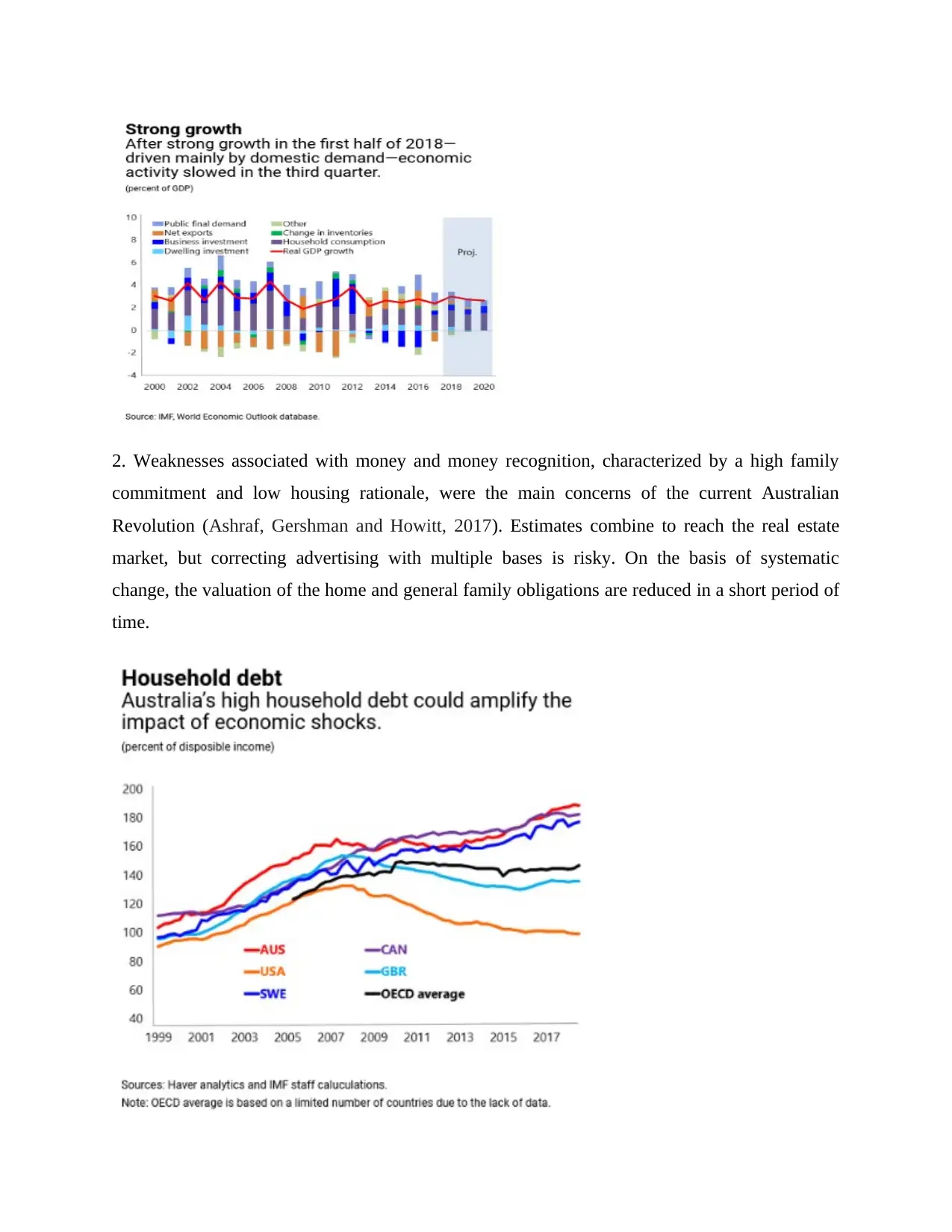
2. Weaknesses associated with money and money recognition, characterized by a high family
commitment and low housing rationale, were the main concerns of the current Australian
Revolution (Ashraf, Gershman and Howitt, 2017). Estimates combine to reach the real estate
market, but correcting advertising with multiple bases is risky. On the basis of systematic
change, the valuation of the home and general family obligations are reduced in a short period of
time.
commitment and low housing rationale, were the main concerns of the current Australian
Revolution (Ashraf, Gershman and Howitt, 2017). Estimates combine to reach the real estate
market, but correcting advertising with multiple bases is risky. On the basis of systematic
change, the valuation of the home and general family obligations are reduced in a short period of
time.

However, with optional cash flow of 165 percent or higher, the obligation to increase the family
unit in the universal study in any of the following years, as well as the relevant weaknesses.
3. Homes with flexibility in change will be required for the restoration of proper housing.
Although the adjustment of the housing market will contribute, it is unlikely to be sufficient for
widespread and far-reaching moderation and development.
Interest in housing is based on remaining stable, adopting a stronger approach to economic
growth and higher population growth in urban areas. As changes in settlements, places and
individuals become increasingly delayed, changes must be flexibly recorded and therefore
changes in the housing market must not be delayed.
4. One way to reduce reliance on less sustainable sources of subsidy from markets around the
world is by introducing various measures, including enhancing banks' capital gains by: 'the IMF's
valuation for the flexibility of the Australian wealth-rich currency framework. A full-scale
protective surveillance step was taken (Gourio, Messer and Siemer, 2016). Rapid growth in the
most risky part of mortgage, advertising and budget management and enhancing the quality and
unit in the universal study in any of the following years, as well as the relevant weaknesses.
3. Homes with flexibility in change will be required for the restoration of proper housing.
Although the adjustment of the housing market will contribute, it is unlikely to be sufficient for
widespread and far-reaching moderation and development.
Interest in housing is based on remaining stable, adopting a stronger approach to economic
growth and higher population growth in urban areas. As changes in settlements, places and
individuals become increasingly delayed, changes must be flexibly recorded and therefore
changes in the housing market must not be delayed.
4. One way to reduce reliance on less sustainable sources of subsidy from markets around the
world is by introducing various measures, including enhancing banks' capital gains by: 'the IMF's
valuation for the flexibility of the Australian wealth-rich currency framework. A full-scale
protective surveillance step was taken (Gourio, Messer and Siemer, 2016). Rapid growth in the
most risky part of mortgage, advertising and budget management and enhancing the quality and
⊘ This is a preview!⊘
Do you want full access?
Subscribe today to unlock all pages.

Trusted by 1+ million students worldwide
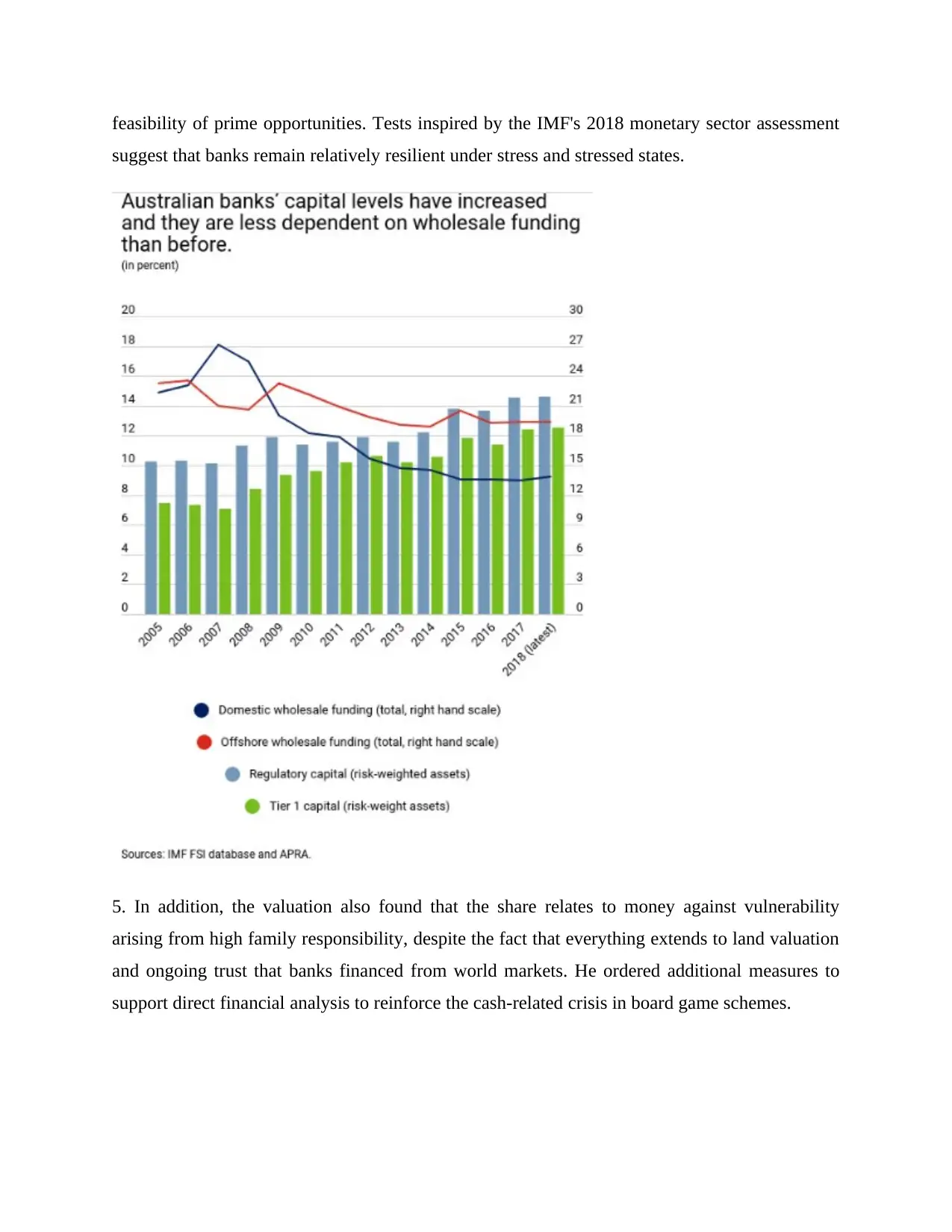
feasibility of prime opportunities. Tests inspired by the IMF's 2018 monetary sector assessment
suggest that banks remain relatively resilient under stress and stressed states.
5. In addition, the valuation also found that the share relates to money against vulnerability
arising from high family responsibility, despite the fact that everything extends to land valuation
and ongoing trust that banks financed from world markets. He ordered additional measures to
support direct financial analysis to reinforce the cash-related crisis in board game schemes.
suggest that banks remain relatively resilient under stress and stressed states.
5. In addition, the valuation also found that the share relates to money against vulnerability
arising from high family responsibility, despite the fact that everything extends to land valuation
and ongoing trust that banks financed from world markets. He ordered additional measures to
support direct financial analysis to reinforce the cash-related crisis in board game schemes.
Paraphrase This Document
Need a fresh take? Get an instant paraphrase of this document with our AI Paraphraser

6. The changes will help increase the ability to develop more attractive periods. The acquisition
of Australia's existing profitability framework reinforces the development of local interest, while
helping to meet the needs of developing populations and establishing a framework for the
development of greater profits in the future (Martins, Gan and Ferreira-Lopes, 2017). Given
Australia's sophisticated infrastructure compared to other advanced economies, the base cost is
an extension to increase profits. Future increases in efficiency may not depend entirely on the
structure. The national vitality strategy needs to reduce the sensitivity of agreements and catalyze
profitability. A more comprehensive modification of the valuation would be useful if one aims to
use increasingly effective bonds with stable fundamentals, such as GST and land tariffs, while
excessively generous obligations reduce concessions.
of Australia's existing profitability framework reinforces the development of local interest, while
helping to meet the needs of developing populations and establishing a framework for the
development of greater profits in the future (Martins, Gan and Ferreira-Lopes, 2017). Given
Australia's sophisticated infrastructure compared to other advanced economies, the base cost is
an extension to increase profits. Future increases in efficiency may not depend entirely on the
structure. The national vitality strategy needs to reduce the sensitivity of agreements and catalyze
profitability. A more comprehensive modification of the valuation would be useful if one aims to
use increasingly effective bonds with stable fundamentals, such as GST and land tariffs, while
excessively generous obligations reduce concessions.
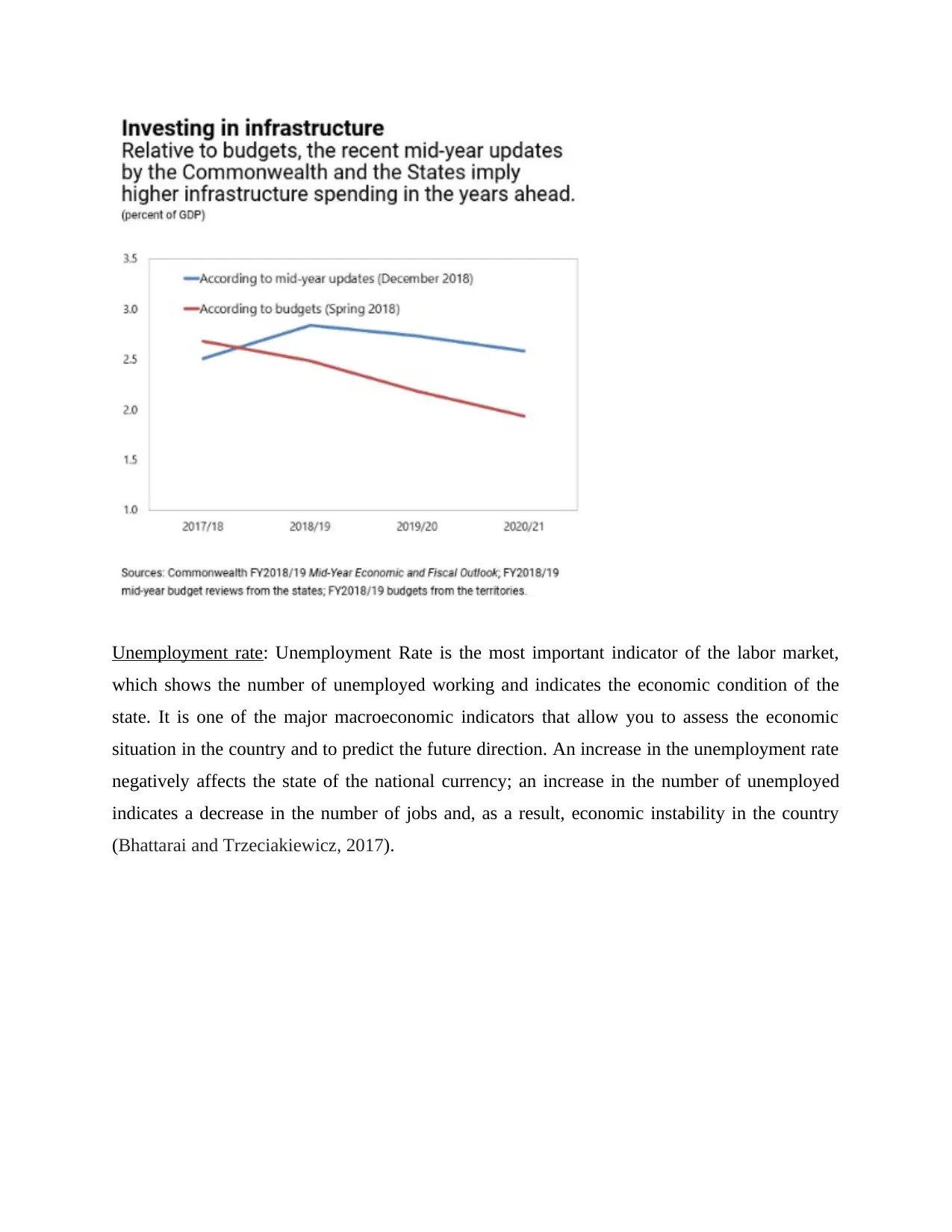
Unemployment rate: Unemployment Rate is the most important indicator of the labor market,
which shows the number of unemployed working and indicates the economic condition of the
state. It is one of the major macroeconomic indicators that allow you to assess the economic
situation in the country and to predict the future direction. An increase in the unemployment rate
negatively affects the state of the national currency; an increase in the number of unemployed
indicates a decrease in the number of jobs and, as a result, economic instability in the country
(Bhattarai and Trzeciakiewicz, 2017).
which shows the number of unemployed working and indicates the economic condition of the
state. It is one of the major macroeconomic indicators that allow you to assess the economic
situation in the country and to predict the future direction. An increase in the unemployment rate
negatively affects the state of the national currency; an increase in the number of unemployed
indicates a decrease in the number of jobs and, as a result, economic instability in the country
(Bhattarai and Trzeciakiewicz, 2017).
⊘ This is a preview!⊘
Do you want full access?
Subscribe today to unlock all pages.

Trusted by 1+ million students worldwide

Interpretation: The above unemployment graph indicates that, the lowest unemployment rate of
Australia was in 2019 and highest was in the mid-of 2015 and 2016. There are lots of
fluctuations which can be seen since 20015; but over the year a steady decline in growth of
unemployment rate is visible. But after 2019; due to impact of economic crises, again the rate
rises at the top.
B) Negative impact of COVID-19 on economy
The impact of COVID-19 is to some degree questionable. During this period, there are huge
advantages for the network and governments in acquiring social and monetary data in an
opportune way. ABS is reacting worldwide by revealing various new figures to assist us with
understanding the effect of this wonder. Approximately seventy-five percent (72%) of Australian
companies said a decrease in business-based revenue would affect operations over the next two
months, as revealed by the results of a third review by the Australian Bureau of Statistics (ABS)
on the commercial impacts of COVID -19.
Australia was in 2019 and highest was in the mid-of 2015 and 2016. There are lots of
fluctuations which can be seen since 20015; but over the year a steady decline in growth of
unemployment rate is visible. But after 2019; due to impact of economic crises, again the rate
rises at the top.
B) Negative impact of COVID-19 on economy
The impact of COVID-19 is to some degree questionable. During this period, there are huge
advantages for the network and governments in acquiring social and monetary data in an
opportune way. ABS is reacting worldwide by revealing various new figures to assist us with
understanding the effect of this wonder. Approximately seventy-five percent (72%) of Australian
companies said a decrease in business-based revenue would affect operations over the next two
months, as revealed by the results of a third review by the Australian Bureau of Statistics (ABS)
on the commercial impacts of COVID -19.
Paraphrase This Document
Need a fresh take? Get an instant paraphrase of this document with our AI Paraphraser
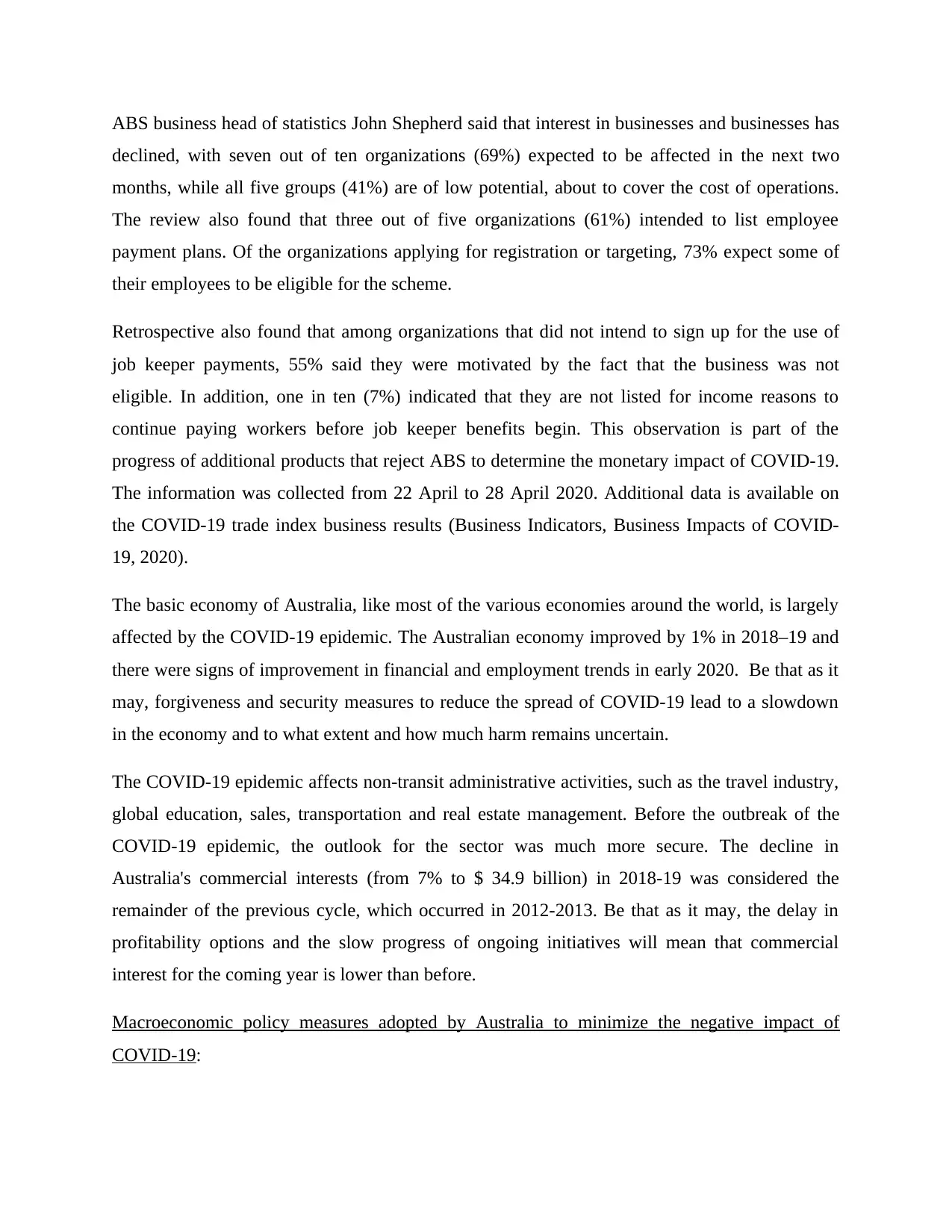
ABS business head of statistics John Shepherd said that interest in businesses and businesses has
declined, with seven out of ten organizations (69%) expected to be affected in the next two
months, while all five groups (41%) are of low potential, about to cover the cost of operations.
The review also found that three out of five organizations (61%) intended to list employee
payment plans. Of the organizations applying for registration or targeting, 73% expect some of
their employees to be eligible for the scheme.
Retrospective also found that among organizations that did not intend to sign up for the use of
job keeper payments, 55% said they were motivated by the fact that the business was not
eligible. In addition, one in ten (7%) indicated that they are not listed for income reasons to
continue paying workers before job keeper benefits begin. This observation is part of the
progress of additional products that reject ABS to determine the monetary impact of COVID-19.
The information was collected from 22 April to 28 April 2020. Additional data is available on
the COVID-19 trade index business results (Business Indicators, Business Impacts of COVID-
19, 2020).
The basic economy of Australia, like most of the various economies around the world, is largely
affected by the COVID-19 epidemic. The Australian economy improved by 1% in 2018–19 and
there were signs of improvement in financial and employment trends in early 2020. Be that as it
may, forgiveness and security measures to reduce the spread of COVID-19 lead to a slowdown
in the economy and to what extent and how much harm remains uncertain.
The COVID-19 epidemic affects non-transit administrative activities, such as the travel industry,
global education, sales, transportation and real estate management. Before the outbreak of the
COVID-19 epidemic, the outlook for the sector was much more secure. The decline in
Australia's commercial interests (from 7% to $ 34.9 billion) in 2018-19 was considered the
remainder of the previous cycle, which occurred in 2012-2013. Be that as it may, the delay in
profitability options and the slow progress of ongoing initiatives will mean that commercial
interest for the coming year is lower than before.
Macroeconomic policy measures adopted by Australia to minimize the negative impact of
COVID-19:
declined, with seven out of ten organizations (69%) expected to be affected in the next two
months, while all five groups (41%) are of low potential, about to cover the cost of operations.
The review also found that three out of five organizations (61%) intended to list employee
payment plans. Of the organizations applying for registration or targeting, 73% expect some of
their employees to be eligible for the scheme.
Retrospective also found that among organizations that did not intend to sign up for the use of
job keeper payments, 55% said they were motivated by the fact that the business was not
eligible. In addition, one in ten (7%) indicated that they are not listed for income reasons to
continue paying workers before job keeper benefits begin. This observation is part of the
progress of additional products that reject ABS to determine the monetary impact of COVID-19.
The information was collected from 22 April to 28 April 2020. Additional data is available on
the COVID-19 trade index business results (Business Indicators, Business Impacts of COVID-
19, 2020).
The basic economy of Australia, like most of the various economies around the world, is largely
affected by the COVID-19 epidemic. The Australian economy improved by 1% in 2018–19 and
there were signs of improvement in financial and employment trends in early 2020. Be that as it
may, forgiveness and security measures to reduce the spread of COVID-19 lead to a slowdown
in the economy and to what extent and how much harm remains uncertain.
The COVID-19 epidemic affects non-transit administrative activities, such as the travel industry,
global education, sales, transportation and real estate management. Before the outbreak of the
COVID-19 epidemic, the outlook for the sector was much more secure. The decline in
Australia's commercial interests (from 7% to $ 34.9 billion) in 2018-19 was considered the
remainder of the previous cycle, which occurred in 2012-2013. Be that as it may, the delay in
profitability options and the slow progress of ongoing initiatives will mean that commercial
interest for the coming year is lower than before.
Macroeconomic policy measures adopted by Australia to minimize the negative impact of
COVID-19:
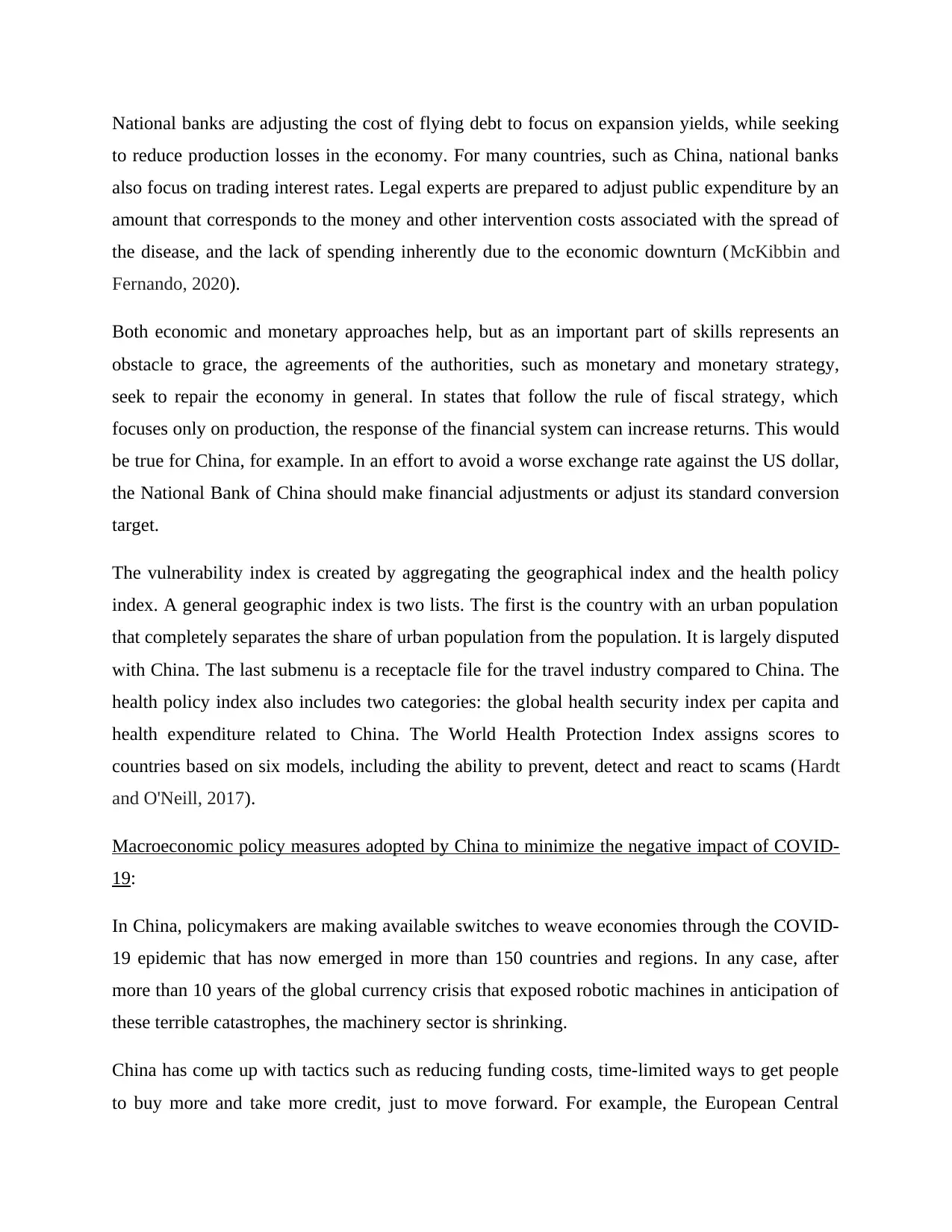
National banks are adjusting the cost of flying debt to focus on expansion yields, while seeking
to reduce production losses in the economy. For many countries, such as China, national banks
also focus on trading interest rates. Legal experts are prepared to adjust public expenditure by an
amount that corresponds to the money and other intervention costs associated with the spread of
the disease, and the lack of spending inherently due to the economic downturn (McKibbin and
Fernando, 2020).
Both economic and monetary approaches help, but as an important part of skills represents an
obstacle to grace, the agreements of the authorities, such as monetary and monetary strategy,
seek to repair the economy in general. In states that follow the rule of fiscal strategy, which
focuses only on production, the response of the financial system can increase returns. This would
be true for China, for example. In an effort to avoid a worse exchange rate against the US dollar,
the National Bank of China should make financial adjustments or adjust its standard conversion
target.
The vulnerability index is created by aggregating the geographical index and the health policy
index. A general geographic index is two lists. The first is the country with an urban population
that completely separates the share of urban population from the population. It is largely disputed
with China. The last submenu is a receptacle file for the travel industry compared to China. The
health policy index also includes two categories: the global health security index per capita and
health expenditure related to China. The World Health Protection Index assigns scores to
countries based on six models, including the ability to prevent, detect and react to scams (Hardt
and O'Neill, 2017).
Macroeconomic policy measures adopted by China to minimize the negative impact of COVID-
19:
In China, policymakers are making available switches to weave economies through the COVID-
19 epidemic that has now emerged in more than 150 countries and regions. In any case, after
more than 10 years of the global currency crisis that exposed robotic machines in anticipation of
these terrible catastrophes, the machinery sector is shrinking.
China has come up with tactics such as reducing funding costs, time-limited ways to get people
to buy more and take more credit, just to move forward. For example, the European Central
to reduce production losses in the economy. For many countries, such as China, national banks
also focus on trading interest rates. Legal experts are prepared to adjust public expenditure by an
amount that corresponds to the money and other intervention costs associated with the spread of
the disease, and the lack of spending inherently due to the economic downturn (McKibbin and
Fernando, 2020).
Both economic and monetary approaches help, but as an important part of skills represents an
obstacle to grace, the agreements of the authorities, such as monetary and monetary strategy,
seek to repair the economy in general. In states that follow the rule of fiscal strategy, which
focuses only on production, the response of the financial system can increase returns. This would
be true for China, for example. In an effort to avoid a worse exchange rate against the US dollar,
the National Bank of China should make financial adjustments or adjust its standard conversion
target.
The vulnerability index is created by aggregating the geographical index and the health policy
index. A general geographic index is two lists. The first is the country with an urban population
that completely separates the share of urban population from the population. It is largely disputed
with China. The last submenu is a receptacle file for the travel industry compared to China. The
health policy index also includes two categories: the global health security index per capita and
health expenditure related to China. The World Health Protection Index assigns scores to
countries based on six models, including the ability to prevent, detect and react to scams (Hardt
and O'Neill, 2017).
Macroeconomic policy measures adopted by China to minimize the negative impact of COVID-
19:
In China, policymakers are making available switches to weave economies through the COVID-
19 epidemic that has now emerged in more than 150 countries and regions. In any case, after
more than 10 years of the global currency crisis that exposed robotic machines in anticipation of
these terrible catastrophes, the machinery sector is shrinking.
China has come up with tactics such as reducing funding costs, time-limited ways to get people
to buy more and take more credit, just to move forward. For example, the European Central
⊘ This is a preview!⊘
Do you want full access?
Subscribe today to unlock all pages.

Trusted by 1+ million students worldwide
1 out of 16
Related Documents
Your All-in-One AI-Powered Toolkit for Academic Success.
+13062052269
info@desklib.com
Available 24*7 on WhatsApp / Email
![[object Object]](/_next/static/media/star-bottom.7253800d.svg)
Unlock your academic potential
Copyright © 2020–2025 A2Z Services. All Rights Reserved. Developed and managed by ZUCOL.





